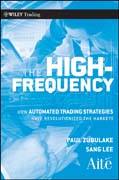
The high frequency game changer: how automated trading strategies have revolutionized the markets
Zubulake, Paul
Lee, Sang
INDICE: Introduction. Acknowledgments. Chapter 1 Birth of High Frequency Trading Equity Markets Go Electronic Defining High Frequency Trading. Who are the High Frequency Traders? Impact of High Frequency Trading. Building a High Frequency Trading Team. Chapter 2 Market Structure. Order Handling Rules of 1997. Growth of ECNs. Regulation NMS. Market Fragmentation versus Competition. Dark Pools. Block Trading Dark Pools. Agency Dark Pools. Consortium Dark Pools. Exchange Dark Pools. Internalization Dark Pools. Key Trends in Dark Pools. IOIs, IOCs, and Liquidity Mapping. Growing Presence of High Frequency Flow. Calls for Regulation. Focus on Anti-Gaming Functionality. Growth of Dark Pools. Defining the Role of Dark Pools. Chapter 3 Trading Infrastructure. Rise of High Performance Technology Vendors. Key Components of High Performance Infrastructure. Feed Handlers. Ticker Plant. Messaging Middleware. Storage. Networking. Co-location. Sponsored Access. Chapter 4 Liquidity. HFT as Liquidity Providers. Flash Crash. Chapter 5 Trading Strategies. Examples of Algorithms. Order Types.High Frequency Trading and Predatory Algorithms. Chapter 6 Expansion in High Frequency Trading-Futures Markets. Current Landscape in Futures Markets. OrderGeneration Proprietary Trading. Fixed Income. Foreign Exchange Market. Key Market Trends in FX. Global FX Market Volume Estimates. Adoption of Electronic Trading. Bank Internalization. Increasing Presence of Client-to-Dealer Market. Historical Look at HFT in FX. Projected Presence of HFT in FX. Equity Options.Expansion into Global Markets. Regulatory Disparity. Need for Local Customer Education and Change in Local Structure. Emergence of Alternative Execution Venues. Adoption of DMA and Algorithms. Projected Adoption of High Frequency Trading. South America. Chapter 7 Positives and Possibilities. Commoditizing HighFrequency Trading. Trading Technology Demands and Preferences. Internal Focus. Choosing Vendors. Finding the Next Opportunity. Issues and Risks. Order Routing Gets Smart. Smart Order Routings Future. Is Artificial Intelligence Next? Economic Indicators. News. SEC Filings. Chapter 8 Credit Crisis of 2008. The Blame Game. U.S. Federal Reserve. Regulatory Agencies. Credit Agencies. Politicians. End-Users of Derivative Products. Recent Regulatory History. Financial Modernization Act of 1999. Commodity Futures Modernization Act of 2000. Dodd Frank Wall Street Reform Act of 2010. Ending Too Big to Fail Bailouts. Creating Transparency and Accountability for Derivatives. Hedge Funds. Credit Rating Agencies. Executive Compensation and Corporate Governance. Impact of Potential Regulations and Rule ChangesSEC Concept Release. Chapter 9 Conclusion. Glossary. About the Authors. Index.
- ISBN: 978-0-470-77038-2
- Editorial: John Wiley & Sons
- Encuadernacion: Cartoné
- Páginas: 208
- Fecha Publicación: 17/02/2011
- Nº Volúmenes: 1
- Idioma: Inglés
